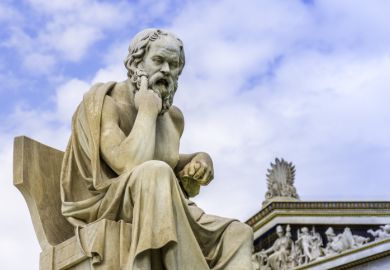Never judge a book by its cover." But here we can make a partial exception: Martha Nussbaum herself chose the cover - a rather ugly photograph of dead white trees against green living ones and a deep blue sky - because it "seemsIto capture strikingly some of the imagery" explored in her lengthy discussion of Seneca's Medea, including the "strange hot light Icoming, as it were, from Medea's countercosmos, set over against the world of Stoic virtue". A reviewer is lucky to find so neatly encapsulated the virtues and vices of a book. Much of what Nussbaum has to say is at least plausible, often striking. But her own agenda, perhaps precisely because of the seriousness of its humane commitment, tends at crucial junctures to get in the way of detailed analysis and of larger philosophical interpretation and evaluation.
But what is Nussbaum doing, analysing a play in a book about philosophy, specifically, the "therapy of the soul" offered by the Hellenistic philosophical schools, Stoic, Epicurean and sceptic, to a humanity made "sick" by its susceptibility to the passions - anger, fear, love etc? The question might seem to answer itself: the Medea is a demonstration of the terrible power of love, and so a sort of horrible warning issued to the rest of us by its author, Seneca the younger, popularly identified as Stoic. The Epicureans, too, were fond of horrible warnings as a persuasive technique, as Nussbaum shows in her discussions of Lucretian poetry.
But things are not so simple. Nussbaum sees in the Medea's grotesque, bloody finale "the triumph of love", finding in the text allusions I could not detect (the "red-light" surrounding Medea on the palace roof is "present" only because, we have been told, the palace is burning to the ground; and Jason "twining in ecstasy around his partner", as one of the snakes pulling Medea's chariot, is a product of Nussbaum's overheated imagination). Again, Nussbaum does not always sufficiently acknowledge the extent of Seneca's unorthodoxy: the play can hardly, as she claims, show that "Stoicism has bitten itself". Rather it embodies "Seneca's criticism of Stoic purity" - of the school's rejection of all goods but moral ones, and its claim that virtue suffices for eudaimonia, the condition of human flourishing that all the Hellenistic schools took as their goal, while fighting viciously about what it is and how to get there.
The single most curious fact about this book, for all its attention to the analogy with bodily medicine that was enthusiastically endorsed by these philosophers, to their self-presentation as doctors of the ills of the soul, and to what this means for the nature and value of their medical equipment (the arguments they use to rid us of our false and dangerous beliefs about what the world is like and what is important in it), is that Nussbaum devotes a scant two sides of print to the motivation behind the whole business. Even if philosophy can "cure" me of fear, hate, anger and the like, why should I bother to pass on the good news - or rather the medication - to the next woman? (All Nussbaum's protagonists are female unless proven otherwise). And this motivation must come from inside the philosophy if it is to be worth anything at all. We are told that Nussbaum's character Nikidion, imaginary recipient of the various "therapists" offered by the schools (as well as - a useful foil - by Aristotle), and of Nussbaum's (re-)reading of the Medea, moves to Stoicism because "she wants to feel herself a member of a community, and to care for the good of all human beings in the community." But Nussbaum merely remarks on "the apparent tension between compassion and freedom from disturbance", the latter being typically equated with eudaimonia, and itself an object of Nussbaum's criticisms. The problem is particularly acute because of Nussbaum's frequent and unconvincing comparisons with modern psychotherapy and psychoanalysis. It is not just the unavoidable moral dimension of Hellenistic "therapy" that constantly vitiates the analogy: do shrinks do it just for love of their fellows?
It is hard to feel harshly towards a writer who donates the proceeds of a book to Amnesty International. But even here warning bells ring. Nussbaum acknowledges, as her Hellenistic subjects, I take it, would not, that philosophy is "not enough". And she is silent on the gulfs dividing the ideologies adopted or deployed by the world's multifarious governmental institutions: she seeks instead to help put right the "damages caused by anger and hatred in public life". If only it were that simple.
Catherine Atherton is a fellow of New College, Oxford.
The Therapy of Desire: Theory and Practice in Hellenistic Ethics
Author - Martha C. Nussbaum
ISBN - 691 03342 0
Publisher - Princeton University Press
Price - £22.50
Pages - 558
Register to continue
Why register?
- Registration is free and only takes a moment
- Once registered, you can read 3 articles a month
- Sign up for our newsletter
Subscribe
Or subscribe for unlimited access to:
- Unlimited access to news, views, insights & reviews
- Digital editions
- Digital access to THE’s university and college rankings analysis
Already registered or a current subscriber?



